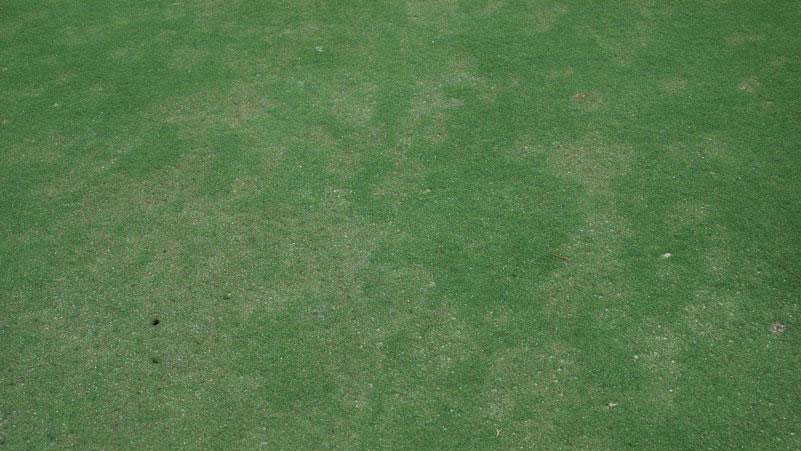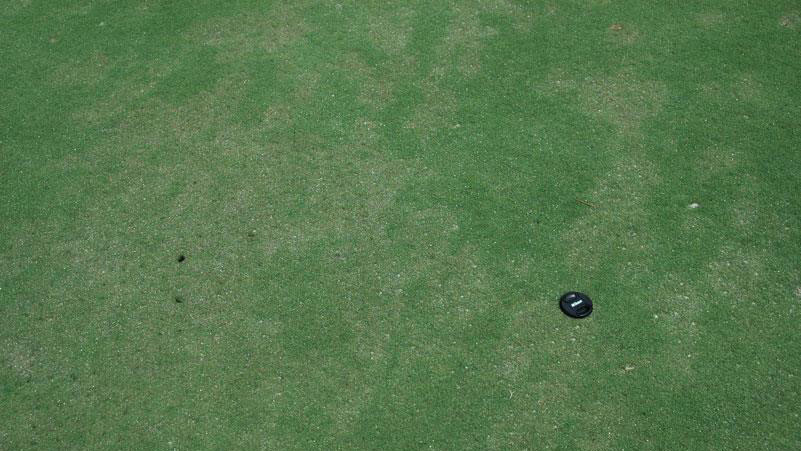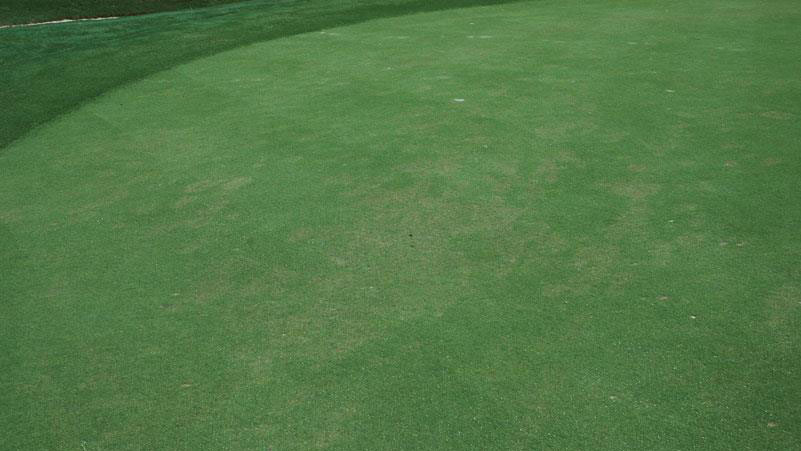Pythium Root Rot in Turf
en Español / em Português
El inglés es el idioma de control de esta página. En la medida en que haya algún conflicto entre la traducción al inglés y la traducción, el inglés prevalece.
Al hacer clic en el enlace de traducción se activa un servicio de traducción gratuito para convertir la página al español. Al igual que con cualquier traducción por Internet, la conversión no es sensible al contexto y puede que no traduzca el texto en su significado original. NC State Extension no garantiza la exactitud del texto traducido. Por favor, tenga en cuenta que algunas aplicaciones y/o servicios pueden no funcionar como se espera cuando se traducen.
Português
Inglês é o idioma de controle desta página. Na medida que haja algum conflito entre o texto original em Inglês e a tradução, o Inglês prevalece.
Ao clicar no link de tradução, um serviço gratuito de tradução será ativado para converter a página para o Português. Como em qualquer tradução pela internet, a conversão não é sensivel ao contexto e pode não ocorrer a tradução para o significado orginal. O serviço de Extensão da Carolina do Norte (NC State Extension) não garante a exatidão do texto traduzido. Por favor, observe que algumas funções ou serviços podem não funcionar como esperado após a tradução.
English
English is the controlling language of this page. To the extent there is any conflict between the English text and the translation, English controls.
Clicking on the translation link activates a free translation service to convert the page to Spanish. As with any Internet translation, the conversion is not context-sensitive and may not translate the text to its original meaning. NC State Extension does not guarantee the accuracy of the translated text. Please note that some applications and/or services may not function as expected when translated.
Collapse ▲Symptoms
Pythium root rot is a persistent problem in areas that are poorly drained or over-irrigated. The disease can also occur in well-drained areas following extended periods of rainfall. Pythium root rot can occur at any time of the year as long as the soil remains saturated for several days or weeks. From a distance, symptoms are orange or yellow and usually appear in irregular patterns, but occasionally develop in spots or distinct patches. Symptoms of Pythium root rot may spread in drainage patterns during periods of heavy rainfall. On individual plants, the crowns, roots, rhizomes, and/or stolons will appear dark and greasy. The depth and density of roots will be drastically reduced in affected areas.
Development Factors
There are many species of Pythium that have the ability to cause root rot of turfgrasses. As a result, Pythium root rot can develop at any time during the growing season if the soil remains saturated for prolonged periods. Poor surface or subsurface drainage, over-irrigation, heavy rainfalls, and excessive thatch and organic matter accumulation are the most common factors that lead to a Pythium root rot outbreak.
Cultural Control
Avoid establishing turfgrasses in poorly drained areas that remain saturated for extended periods. Golf course putting greens must be aerified and topdressed regularly to control thatch and reduce organic matter accumulation. In general, 15% to 20% of the putting green surface area should be impacted by hollow-tine aerification annually, and 5,000 lbs of topdressing should be applied per 1,000 square feet each year. Pruning or removal of trees surrounding putting greens to increase sunlight penetration and air movement will reduce Pythium root rot activity. Installation of high-powered fans will also help to alleviate the problem where air movement is restricted. For golf course putting greens with poor internal drainage, reconstruction is the only practical long-term solution for Pythium root rot.
Chemical Control
Where this disease has been a persistent problem, apply labeled fungicides every 14 to 21 days during the growing season or when rainfall occurs for 2 to 3 consecutive days. For curative applications, first apply ethazole then follow with an application of cyazofamid, picarbutrazox, mefenoxam, or propamocarb 2 to 3 days later. To minimize the potential for foliar burn, ethazole must be watered-in immediately after application with at least 1⁄8 inch of water. Other fungicides should also be watered-in with at least 1⁄8 inch to drive the active ingredient into the root zone where the Pythium root rot pathogens are most active.
* Products marked with an asterisk are not labeled for home lawn use.
| Fungicide and Formulation1 | Amount of Formulation2 | Application Interval (Days)3 | Efficacy Rating | Resistance Risk | FRAC Code4 |
| azoxystrobin (Heritage) WG TL G |
0.4 2 2 to 4 |
10 to 14 10 to 14 10 to 14 |
++ | Medium | 11 |
| azoxystrobin + propiconazole (Headway) ME G |
3 2 to 4 lbs |
10 to 14 14 to 28 |
++ | Medium | 11/3 |
| azoxystrobin + tebuconazole (Strobe T)* | 0.75 to 1.5 | 10 to 21 | ++ | Medium | 11/3 |
| chlorothalonil + fluoxastrobin (Fame C)* | 3 to 5.9 | 7 to 10 | ++ | Medium | M5/11 |
| cyazofamid (Segway) | 0.45 to 0.9 | 14 to 21 | ++++ | Medium | 21 |
|
cyazofamid + azoxystrobin (Union) |
2.9 to 5.75 | 14 to 21 | ++++ | Medium | 21/11 |
| ethazole (Koban)* (Terrazole)* |
4.5 2 to 4 |
10 10 to 14 |
+++ | Low | 14 |
| fluoxastrobin (Fame) SC G |
0.18 to 0.36 2.3 to 4.6 lbs |
7 to 10 14 |
++ | Medium | 11 |
| fluoxastrobin + tebuconazole (Fame T)* | 0.45 to 0.9 | 21 | ++ | Medium | 11/3 |
|
fosetyl Al |
4 to 8 2 to 6 |
14 to 21 7 to 21 |
+++ +++ |
Low Low |
33 |
| mefentrifluconazole + pyraclostrobin (Navicon)* | 0.85 | 14 to 28 | ++ | Medium | 3/11 |
| picarbutrazox (Serata) | 0.6 to 0.8 | 14 | ++++ | Medium | U17 |
| potassium phosphite (Appear II)* | 6 to 8 | 7 to 14 | +++ | Low | 33 |
| propamocarb (Banol)* | 1.3 to 4 | 7 to 21 | + | Medium | 28 |
|
Pseudomonas chlororaphis strain AFS009 (Zio) |
1.8 to 6 | 7 to 21 | + | Not Known | BM02 |
|
pydiflumetofen + azoxystrobin + propiconazole (Posterity XT)* |
3 | 14 | ++ | Medium | 7/11/3 |
| 1 Other trade names with the same active ingredients are labeled for use on turfgrasses and can be used according to label directions. 2 Units are oz, fl oz, or lb depending on formulation. Apply fungicides in 2 to 5 gallons of water per 1,000 square feet according to label directions. Use lower rates for preventive and higher rates for curative applications. 3 Use shorter intervals when conditions are very favorable for disease. 4 Fungicide Resistance Action Committe code. Products with same code have the same mode of action and are in the same chemical class. * Products marked with an asterisk are not labeled for home lawn use. |
|||||
| Efficacy Rating ++++ = excellent control when conditions are highly favorable for disease development +++ = good control when disease pressure is high, excellent control when disease pressure is moderate ++ = good control when disease pressure is moderate, excellent control when disease pressure is low + = good control when disease pressure is low ? = not rated due to insufficient data |
|||||
| Resistance Risk Low = Rotate to different chemical class after 3-4 applications; tank mixing not necessary Medium = Rotate to different chemical class after 1-2 applications; tank-mixing with low or medium risk product recommended High = Rotate to different chemical class after EVERY application; tank-mix with low or medium risk product for EVERY application ? = not rated due to insufficient data |
|||||
Species Data
- HOST SPECIES
- all
- MONTHS WITH SYMPTOMS
- all
- STAND SYMPTOMS
- FOLIAR SYMPTOMS LOCATION / SHAPE
- dieback from leaf tip, blighting of entire leaves
- FOLIAR SYMPTOMS COLOR
- tan, yellow, orange
- ROOT / CROWN SYMPTOMS
- roots, stolons, rhizomes, and/or crowns dark brown or black
- FUNGAL SIGNS
- none







